What’s new in Google News – with Barry Adams

With the 20th birthday of Google News coming up, Google launched a new version of Google News last week. Barry Adams, the news SEO specialist, sheds light on the new look of Google News in this post. What are the exact changes, and what does it mean for publishers, readers and SEO? As a bonus, you’ll get some tips to increase your chances to get into Google News!
We also talked about this and more with Barry during Tuesday’s SEO news webinar. Rewatch it or sign up for the next webinar with Areej AbuAli!
What changed in Google News?
Google News has got a new look. Or, more specifically, news.google.com has got a new design. Google described the change in the following way:
Our new look for Google News on desktop was inspired by feedback we received from readers. We’ve made it easier for you to catch up on the most important news by bringing Top stories, Local news and personalized picks for you to the top of the page.
Brand Bender & Olivia Ma – Google
The redesigned Google News home page now looks like this on desktop:
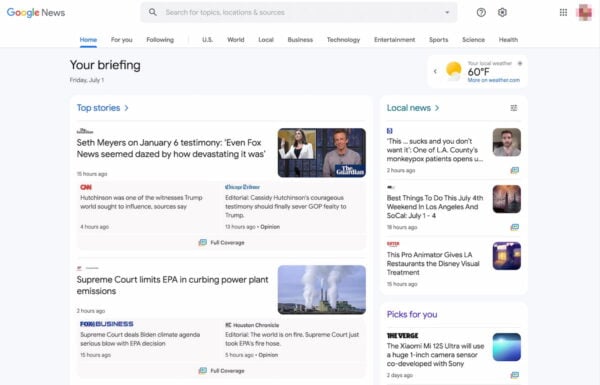
Let’s shortly highlight the three aspects Google mentioned: Top stories, Local news, and Personalized picks.
Top stories
Top stories feature the most important news of that moment. With the current design, they appear at the top of the Google News home page on the desktop. Typically, they show the headlines of major news outlets. One of these articles is featured most prominently; below that article, you can see two alternatives (usually also from big publishers).
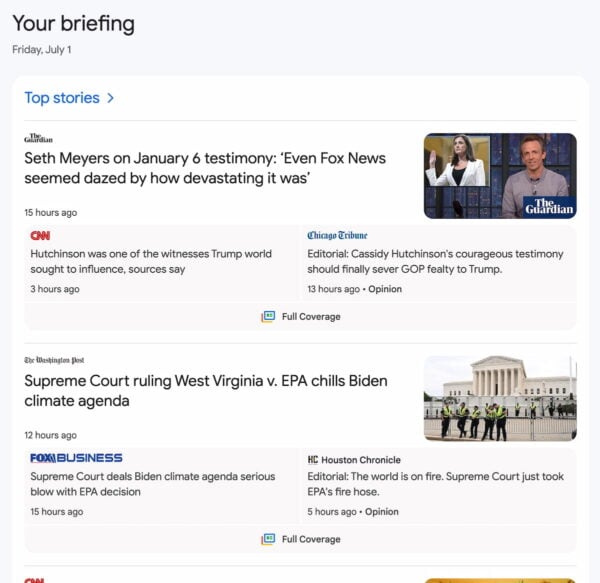
Good to know: when Google detects someone typed a news-oriented search query in their search bar, they can also show Top stories in the usual search results on desktop or mobile in a card-like design.
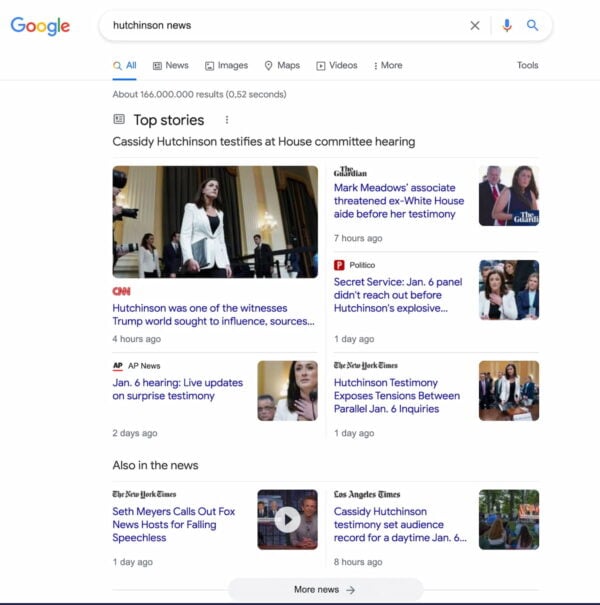
Local news
On the top right, you’ll now find your Local news. Google says they added this selection here because of customer feedback. It features the main news stories of the areas you’re located or interested in. You can set the locations you want to follow with the manage button on the local tab. For Local news to work correctly, you need to log in to your Google account. Otherwise, it will show you more general Picks for you instead of the local news.
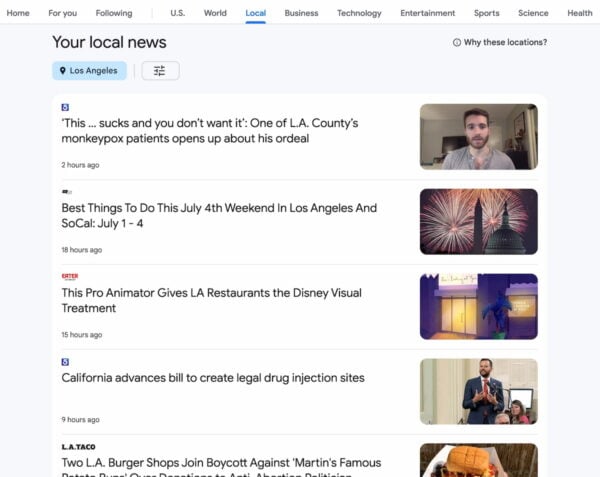
Personalized picks
Lastly, Google News allows you to select and organize the news categories you want to keep track of. It offers big categories such as Business, Technology, and Entertainment. If you click on the customize button next to Your topics, you can select which topics you’re interested in. Google will then show you the three main stories of that category. You can also change the order of the topics, so the most important ones to you are at the top.
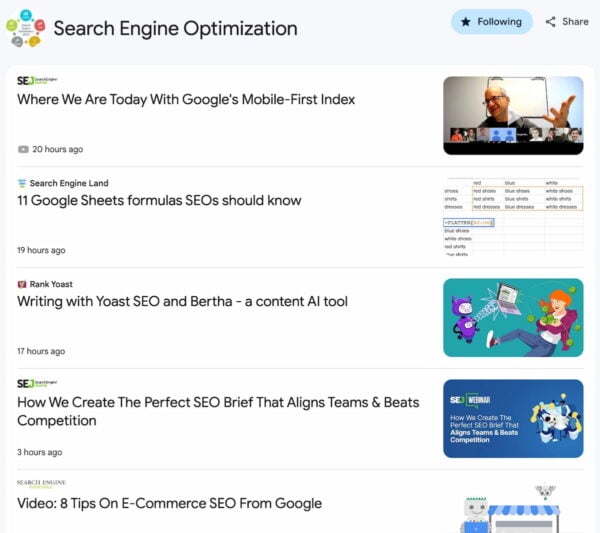
In addition, Google News has improved fact-check features and more ways to learn about the provider of the news item with About this result. So what kind of effects will these changes have? Is it just a new look, or does it entail more? And what does it mean for publishers?
What does this redesign mean for news SEO?
We asked news SEO expert Barry Adams of Polemic Digital about his experiences with the redesign of news.google.com:
“I quite like the new design of Google News. It puts more emphasis on local news and customized news feeds. The old design was a bit funky, but you got used to it in the end. Not particularly modern, so it needed an update. It was also a bit of a hassle to read news from the publications in the area that we live in. So, with the redesign, Google has successfully managed to put that front and center, so good work on that.”
News SEO is more than news.google.com
“Having said that, most people who engage with news on the Google ecosystem never go to the news.google.com sub-domain. Most people use regular search to find their news. If you look at the analytics of any given news publication, you’ll notice that just a fraction of the clicks come from the news.google.com domain. If you look a bit closer, you see that the vast amount of clicks comes from the regular search results. Not the News tab in Google, not the news.google.com domain, but the Top Stories box and related news rich results.”
“The last statistics I read on these is that between 10% and 12% of all Google searches have a news box of some form. And that is where most news publishers will get the bulk of their organic traffic from Google. So while the redesign and new features are nice, most of the news SEO work still goes into trying to get publishers those Top Stories boxes.”
So, how to get there?
“For news SEO to work, you need to take it seriously. Be a news publisher. To rank in Google News, you need a separate website with very little commercial content. Publish nothing but newsworthy content and publish a lot — consistently. Get journalists to write stories. Do this consistently on a highly-optimized website, and you’ll start to see results around two years in. Yes, news SEO is hard work.”
Start optimizing for Google News!
Do you have a news website? Make sure Google picks up on your news articles by using the Yoast News SEO for WordPress plugin!
News SEO tips
So how to optimize for Google News? Apart from creating lots of newsworthy content written by journalists, as Barry says, here are some concrete tips to increase your chances to get into Google News.
Google Publish Center and news guidelines
You’ll need to configure your Google Publisher Center account to manage your presence in Google News. But first, you’ll need to ensure that you abide by Google’s general Search Essentials documentation (formerly known as their webmaster guidelines) and Google News-specific policies. In these guidelines, there are several technical requirements and quality guidelines; most of these are met by using WordPress; assuming you use a standard theme, there are a few things to note.
Technical requirements
- Google News sitemap; a Google news sitemap is “not required but recommended, “according to Google’s documentation. Helpfully, our News SEO plugin automatically generates this for you.
- Optimized feed formats; Google digests news content from feed formats (such as RSS/Atom), so our News SEO plugin does the heavy lifting of structuring and formatting the feeds that WordPress already generates.
Editorial and quality requirements
There are also a few other things you’ll need to improve your chances of getting your site into Google News. Most of it is focused on showing you’re a real publisher, working with actual journalists:
- A contact page listing contact information such as your address, phone numbers and or email addresses. Just a contact form won’t do. Google wants to make sure you’re a legitimate news organization, make sure your site shows you as such.
- A page listing all of your editorial staff. It’s probably wise to make this a listing of author profiles and make sure your author profiles are rich.
- Suitable images: When deciding which image it uses for your article, Google reads schema.org image tags and
og:imagetags, which our core Yoast SEO plugin automatically generates. - Use
NewsArticleandAuthorschema: Using structured data properly for your news content helps Google understand your topics better – and the journalists who wrote the articles.
To conclude
News SEO is a different beast from ‘regular’ SEO. It’s hard to get into the top stories as a new publisher and you might need to work hard for years for Google to even recognize you as a trusted source. Your site has to be technically fit, and Google has to be able to crawl your content quickly. You should use proper NewsArticle structured data and publish high-quality, original news content. Luckily, we have a News SEO WordPress add-on for Yoast SEO that takes care of the technical stuff of news SEO so you can focus on publishing that fantastic content.


Discussion (1)